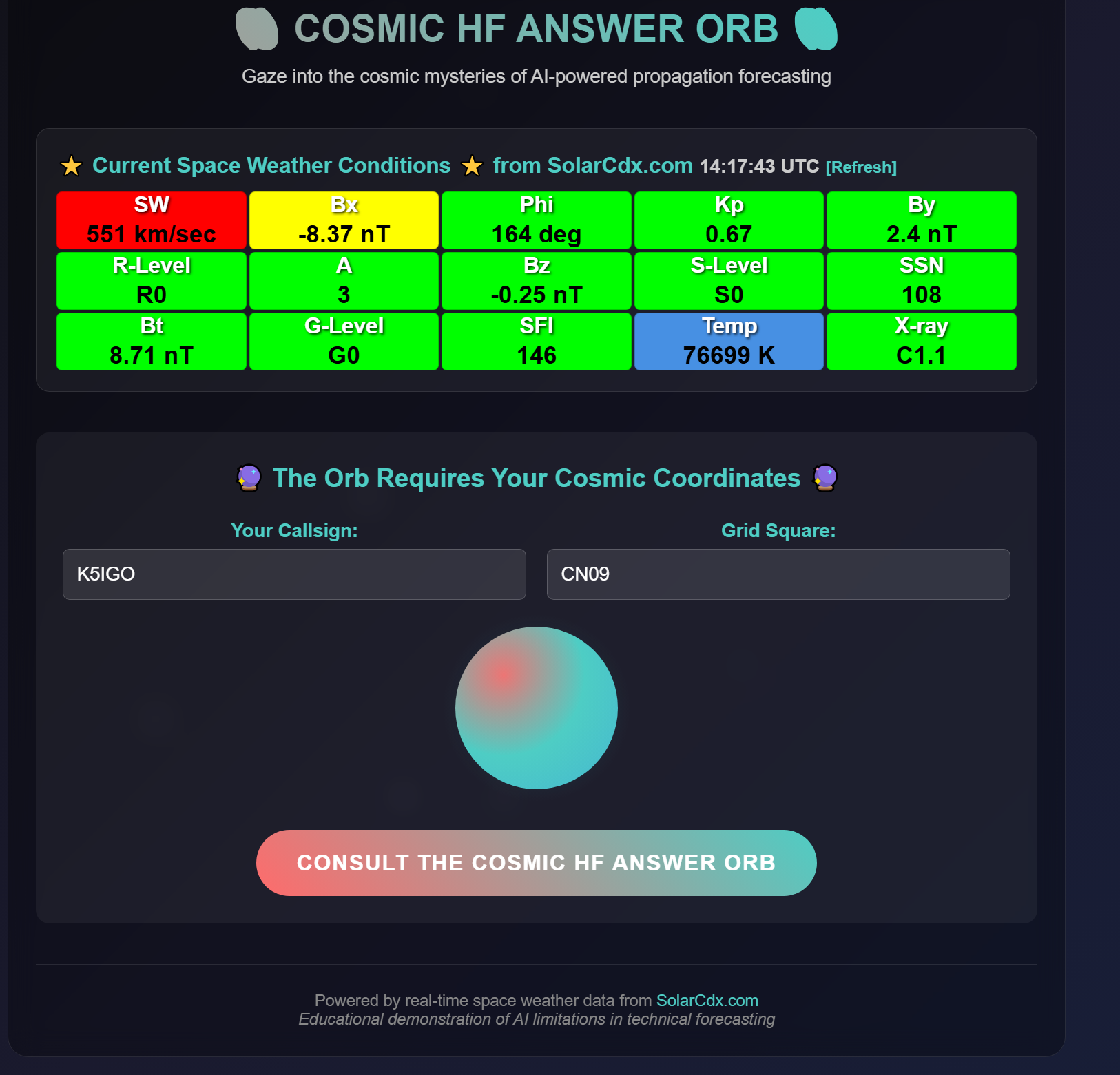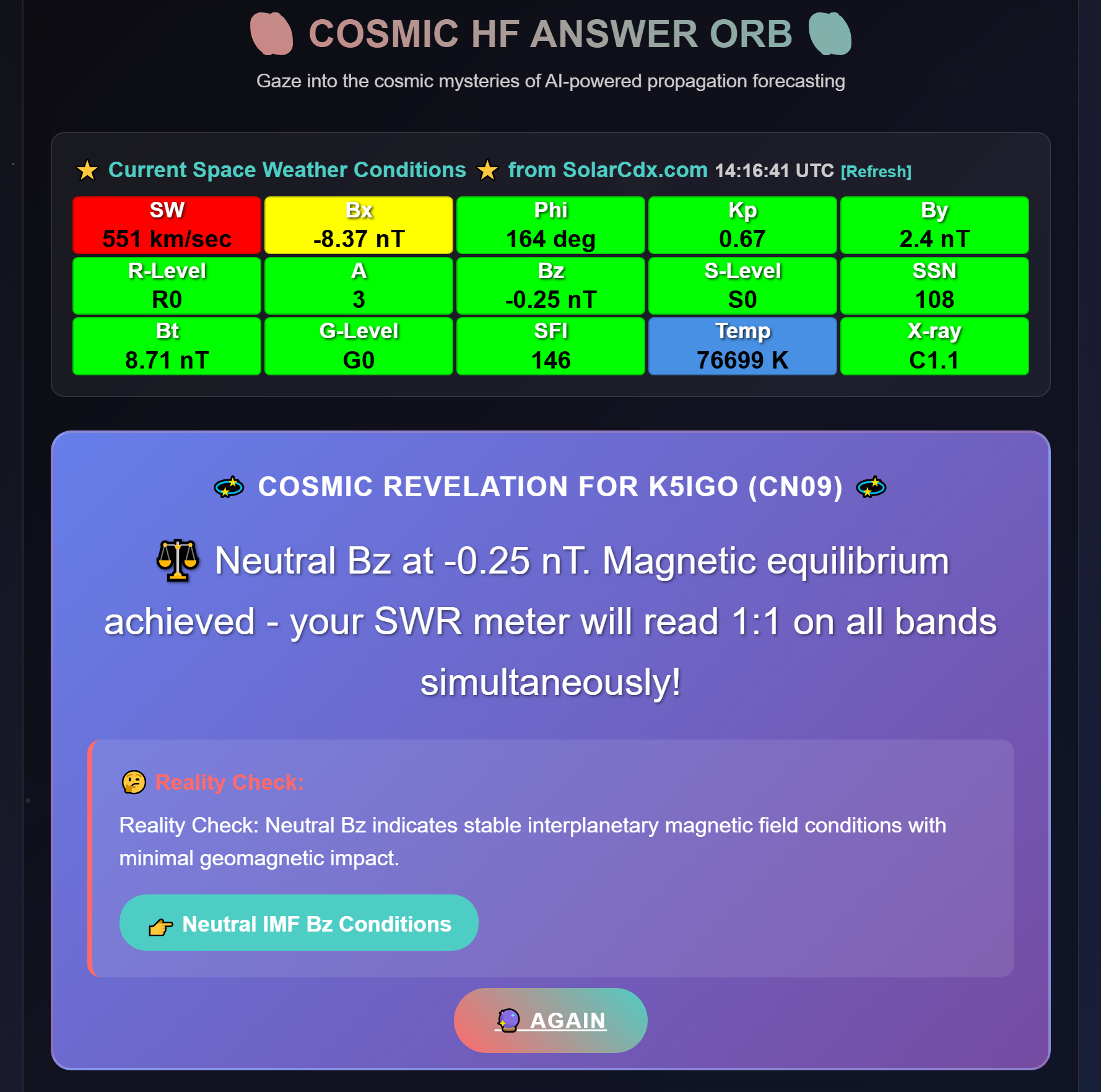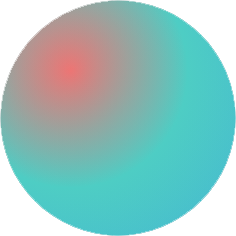About the Cosmic HF Answer Orb
The Journey from Serious Science to Strategic Satire
The Original Vision: Real Science for Real Operators
This project began with the purest of intentions: to create a sophisticated AI-powered tool that would generate accurate HF propagation forecasts for amateur radio operators worldwide.
The concept was elegant in its simplicity. By combining real-time space weather data from multiple authoritative sources with advanced artificial intelligence, we would deliver personalized propagation analysis that considered local time, greyline effects, solar conditions, and geomagnetic activity. Ham operators could input their Maidenhead grid square, city, or coordinates, and receive detailed band-by-band forecasts.
The Technical Foundation: Built for Excellence
Months of development went into creating (not this site) a robust system:
- Real-time Data Integration: Direct APIs to space weather monitoring stations
- Sophisticated Location Parsing: Support for Maidenhead grids, coordinates, and city names
- Solar Calculations: Precise sunrise/sunset and greyline timing
- Comprehensive Prompts: Detailed templates incorporating key space weather parameters
- Multi-Platform Support: Optimized for ChatGPT, Claude, Gemini, and other AI systems
The underlying infrastructure was sound. The space weather data was accurate. The solar calculations were precise. The AI prompt engineering & generation was sophisticated.
The Great AI Experiment: When Intelligence Fails
With technical confidence, we began testing our carefully crafted prompts across major AI platforms. “The results were illuminating ??”
Each model brought something unique to the table, but also exposed the limits of relying on general purpose AI for highly technical tasks.
… “This was not just disagreement. It highlighted why domain specific expertise remains essential in fields like HF radio science.”
Test Scenario: Real Conditions
- Location: Mid-Atlantic Coast (EM93va grid square)
- Time: 20:30 EDT (nighttime conditions)
- Space Weather: Excellent (SFI 187, quiet geomagnetic conditions)
The ChatGPT Response: Technically Sound
ChatGPT delivered what appeared to be credible analysis:
- 20m band rated 55/100 (realistic for nighttime)
- Higher bands properly downgraded after sunset
- Low bands correctly emphasized for nighttime DX
- Professional RF terminology throughout
The Gemini Response: Conservative but Accurate
Google’s Gemini took a measured approach:
- Similar nighttime band assessments
- Clear explanations of propagation physics
- Conservative but realistic scoring
- Educational tone throughout
The Grok Response: Wildly Optimistic
X.ai’s Grok painted a very different picture:
- 20m rated 92/100 at 8:30 PM (improbable)
- 17m and 15m bands rated 85/100 after sunset (absurd)
- Recommendations for high-band DX during local nighttime
- Complete disconnect from propagation reality
The Reliability Crisis/Fabrication Problem
When AI Models Disagree
The EXACT, I mean EXACT same real-time data, fed through identical prompts, produced radically different forecasts. But the problems went deeper than mere disagreement.
“Some AI models produced outputs that looked scientific but did not match physical reality. This revealed a key risk: AI can sound authoritative even when it is wrong. That is why pairing AI with verified space weather data, the kind SolarCdx.com delivers, is so important.”
The Fabrication Problem
ALL THE AI models began generating completely fictional technical parameters:
-
- “MUF currently supports 2530 MHz” (maybe meant 25-30 MHz)
- “D-layer absorption is negative, amplifying signals”
- “Sporadic-E extending to 500 MHz on 6 meters“
- “Geomagnetic conditions favor multi-dimensional propagation”
The Confidence Problem
Most disturbing was how confidently these models presented impossible information. When challenged, they didn’t acknowledge uncertainty, they doubled down with additional fabricated technical details.
The Consistency Problem
Running identical prompts multiple times produced wildly different results from the same AI model. One moment ChatGPT would provide excellent analysis; the next, it would claim you could work Mars on 160 meters.
The Trust Threshold: Why Amateur Radio is Different
The amateur radio community consists largely of engineers, scientists, technicians, and technically-minded professionals. These are people who:
-
- Understand the physics of electromagnetic propagation
- Can spot technical errors immediately
- Have zero tolerance for “close enough” in technical matters
- Will permanently lose trust after a single egregious error
In this community, there’s no “mostly accurate.” An error like “2530 MHz MUF” would instantly and permanently destroy credibility. As one operator noted: “One error like that would send them off, forever.”
The Pivot Point: When Failure Becomes Feature
Faced with AI’s fundamental unreliability for technical, consistant HF forecasting, we had a choice:
-
- Abandon the project
- Continue fighting AI limitations
- Embrace those limitations as an educational tool
We chose option three.
The Strategic Transformation: Education Through Absurdity
If AI models were going to generate impossible predictions anyway, why not make that the point? What if, instead of trying to fix AI’s technical failures, we showcased them as a teaching tool?
Thus was born The Cosmic HF Answer Orb, a deliberate demonstration of why general-purpose AI should never be trusted for serious technical analysis.
The Educational Mission: Serious Learning Through Strategic Humor
Every cosmic prediction serves multiple purposes:
-
- Entertainment: Providing a moment of levity for the ham community
- Education: Demonstrating specific technical impossibilities
- Community Service: Warning operators away from open-ended random AI-generated propagation advice
- Professional Bridge: Connecting users with validated, scientific forecasting methods
This experiment helps HF operators understand the limits of AI only forecasts while pointing them toward real science and correlation engines at SolarCdx.com.
The Technical Foundation Lives On
All the serious engineering work—the real-time APIs, solar calculations, location parsing, and space weather integration remains at the heart of this system. But now it serves to establish technical credibility before delivering the educational message.

When the Orb displays current space weather conditions, and yes, that’s real current space weather on the top of the page, with professional accuracy, users know we understand the real science. This makes the subsequent deliberately absurd predictions even more effective as teaching tools—the contrast between real data and impossible predictions demonstrates exactly why AI fabrication is dangerous.
The Reality Check: Always Educational
Every cosmic prediction is immediately followed by a technical explanation of why it’s impossible, along with links to authoritative sources about how propagation actually works. Users laugh at the absurdity, then learn the real science.
The Professional Bridge: From Entertainment to Excellence
The Orb serves as a friendly warning and a friendly reminder: general AI alone is not enough for serious RF science. That is why SolarCdx.com exists, to combine education, and professional grade space weather intelligence into one ecosystem. It then connects users with purpose built (HF propagation) correlation engines and validated forecasting methods at SolarCdx.com
The Community Response: Mission Accomplished
Early beta testing confirmed our hypothesis. Experienced operators immediately recognized both the humor and the serious educational message. Comments included:
-
- “Finally, someone calling out AI hype in our technical field”
- “Love how it demonstrates real RF knowledge through impossible scenarios”
- “Perfect way to teach new hams why they need real science”
- “Brilliant marketing and it shows expertise while being entertaining”
The Fundamental Reality: Why Space Weather is Like Weather Weather
Space weather, much like terrestrial weather, is inherently messy, chaotic, and requires massive computational resources to predict with any reliability. The National Weather Service operates with billion-dollar budgets, specialized supercomputers, thousands of sensor stations, and decades of refined modeling, and even so, and still gets it wrong regularly.
HF propagation forecasting faces similar challenges:
- Chaotic Systems: Solar activity, geomagnetic interactions, and ionospheric behavior involve complex, non-linear physics
- Massive Data Requirements: Real prediction requires processing vast amounts of real-time data from multiple sources
- Specialized Modeling: Effective forecasting needs purpose-built algorithms, not general-purpose AI
- Correlation Engines: Systems using hundreds of weighted parameters, like SolarCdx.com
The Resource Reality: What Real Accuracy Requires
Commercially Highly Reliable HF propagation forecasting would require:
- Multi-million dollar budgets for specialized AI development
- Purpose-built LLMs trained exclusively on decades of propagation data
- Auto-encoders specifically designed for space weather pattern recognition
- Correlation engines with hundreds of validated parameters
- Continuous refinement by domain experts over years
Without these resources, we’re left with general-purpose AI models that confidently fabricate technical details they don’t understand.
The Broader Message: AI Limitations in Technical Fields
While the Orb focuses on HF propagation, its lessons apply broadly. General-purpose AI models, despite their impressive capabilities in many domains, lack the specialized knowledge, domain-specific training, and computational resources required for reliable technical analysis in complex physical systems. SolarCdx.com proves that when AI is paired with real time NOAA, NASA, USGS and much more data, and guided by domain expertise, it becomes an asset instead of a liability.
This isn’t an anti-AI message, it’s a pro-appropriate-tool message. Use AI for creative writing, general research, and brainstorming. But for mission-critical technical analysis involving chaotic physical systems, you need either:
-
- Multi-billion dollar specialized AI systems (like major weather services)
- Domain experts with validated correlation engines
- Both
Everything else is essentially educated guessing dressed up in confident language.
The Evolution Continues
The Cosmic HF Answer Orb represents the evolution of a serious technical project into something more valuable: a teaching tool that protects our community from unreliable information while connecting them with genuine expertise.
Sometimes the best way to demonstrate why something doesn’t work is to let it fail spectacularly in a controlled, educational environment where that failure serves a greater purpose.
The Bottom Line
We set out to build an AI-powered propagation forecasting tool. We ended up building something better: a demonstration of why amateur radio operators need real science, not artificial intelligence, for reliable technical analysis.
The Orb’s cosmic wisdom may be absurd, but its educational mission is deadly serious. In a world increasingly filled with AI-generated misinformation, we believe the ham radio community deserves better.
That’s why we built the Cosmic HF Answer Orb, not to provide answers, but to help you ask better questions and seek reliable sources for the answers that matter.
Want real propagation science instead of cosmic comedy? Visit SolarCdx.com today.


